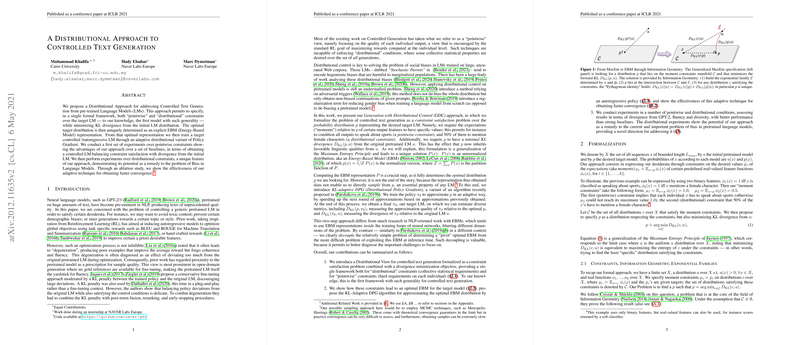A Distributional Approach to Controlled Text Generation
The paper presents a novel distributional approach for controlled text generation from pre-trained LLMs (LMs), leveraging the versatility of energy-based models (EBMs) within a unified framework. This approach accommodates both pointwise and distributional constraints, providing a mechanism to balance constraint satisfaction against maintaining proximity to the initial LM distribution via KL divergence minimization. The research is a significant development in incorporating constraints into text generation while preserving the linguistic qualities of pre-trained models such as GPT-2.
Summary of Methodology
The methodology hinges on a formal constraint satisfaction problem where the desired target distribution is derived by minimizing the KL divergence from the original LM, ensuring that both constraints and linguistic fluency are maintained. The distribution is represented through an EBM, which provides a flexible framework to integrate various constraints effectively. Key phases of the approach include:
- Constraint Specification and EBM Derivation: The approach specifies desired output features in terms of expectations or moments and represents the optimal distribution through an EBM. This step is pivotal as it transforms the constraints into a tangible mathematical formulation, balancing constraint fulfiLLMent and proximity to the original LM.
- Energy-Based Model Implementation: The authors derive the target distribution by defining moment constraints that are solved through an optimization process using self-normalized importance sampling (SNIS). This produces a parameterized representation of the optimal EBM, which serves as a foundation for the subsequent generation task.
- Training Target Policy via KL-Adaptive DPG: To efficiently sample from the EBM while preserving diversity, the authors utilize a variant of the Distributional Policy Gradient (DPG) algorithm. This KL-adaptive version progressively aligns a policy with the target EBM, iteratively refining the proposal distribution to enhance convergence rates and sampling fidelity.
Experimental Investigation and Numerical Insights
Through a comprehensive experimental analysis, including both pointwise and distributional tests, the paper establishes the effectiveness of the proposed framework. Notably, the experiments demonstrate superior performance in maintaining minimal divergence from GPT-2, with promising results in managing the trade-off between constraint satisfaction and generative fluency. The adaptation of hybrid constraints allows for mitigation of bias within LMs, highlighting potential applications in addressing linguistic biases prevalent in large datasets.
Key findings can be summarized as follows:
- The method achieves substantial constraint satisfaction while preserving high-level fluency and diversity in generated sequences.
- Demonstrates capability to impose multiple constraints simultaneously, thereby illustrating its flexibility in complex text generation challenges.
- Outperforms existing baselines (such as REINFORCE, ZIEGLER, and PPLM) by maintaining balance between coherence and constraint adherence without degenerative outputs.
Practical and Theoretical Implications
The framework's emphasis on a distributional balance paves the way for more nuanced text generation systems capable of nuanced bias correction and content steering. The decision to employ a robust EBM-centric approach underlines a shift towards treating LLMs with increased regulation at a distributional level.
Practically, the research suggests avenues for developing more inclusive and controllable AI-driven text applications, appealing to contexts where specific content needs to be prioritized or excluded. Theoretically, the exploration into the adaptive policy refinement through KL-adaptive methods represents a promising advance in reinforcement learning-inspired generative frameworks.
Future Prospects
Future research directions could focus on refining the convergence processes of the KL-adaptive DPG algorithm, enhancing scalability without compromising the quality of the generated text. Incorporating more sophisticated constraint definitions, potentially extending into semantic or pragmatically grounded specifications, could diversify the application scope of this approach. Additionally, investigations might aim to seamlessly integrate MCMC sampling to approach an optimal solution, addressing any residual gaps between theoretical optimality and practical efficiency.
In conclusion, this paper's contributions represent a substantial evolution in controlled text generation, marking a significant step towards more responsive and regulated LLM applications. The techniques and insights provided are likely to influence ongoing advancements not only in natural language processing but across AI-mediated domains necessitating controlled linguistic outputs.
